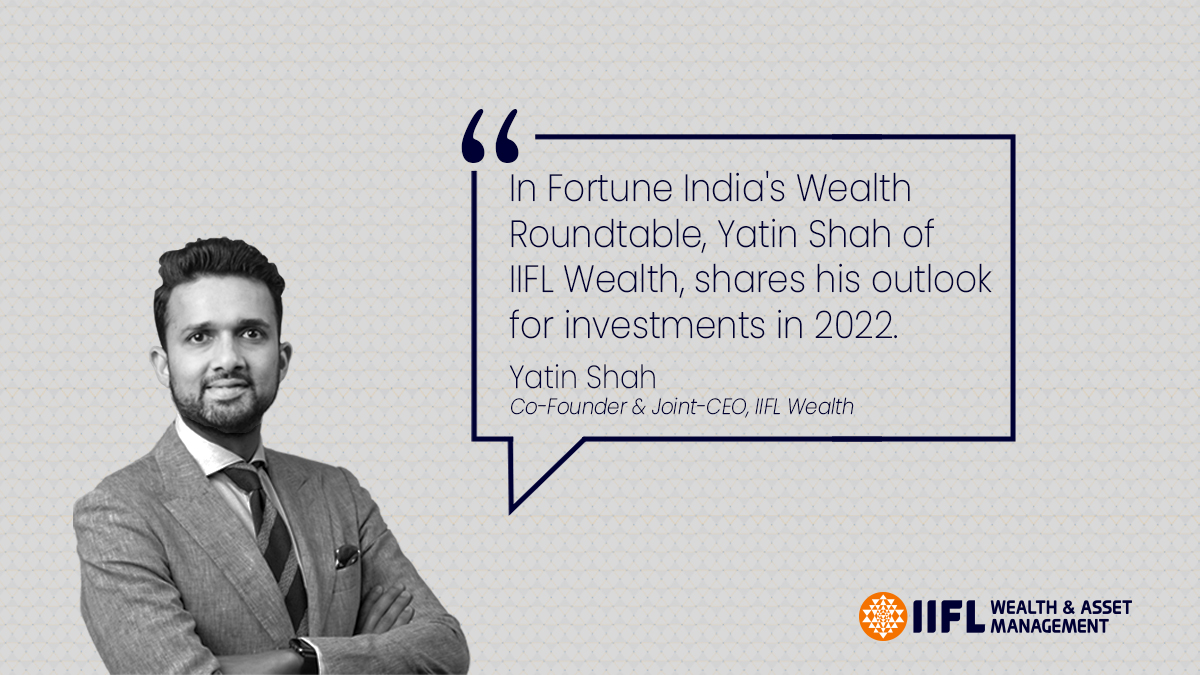
The year 2022 has been a bumper one for the rich and ultra-rich who have invested in the private equity space. Stellar public market debut of new-age tech companies has fuelled interest in unlisted equity of promising start-ups. On Fortune India’s panel of leading wealth managers, Yatin Shah, co-founder and joint CEO, IIFL Wealth & Asset Management, offers a lowdown on the best investment options of 2022. Edited excerpts:
After a record run since the March 2020 low, is the party on the Street now coming to an end?
Yatin Shah: We see a valuation risk across all asset classes. Till Covid is completely out of the picture, we expect a more accommodative monetary policy, hence, the party could continue for some more time. On the inflation front, there’s been a huge amount of disruption on the supply side. Another trend is the shift in power from institutional to retail investors across asset classes. Today, 70% of NSE volume is retail and 50% of option trading volume is nothing but leverage. So, if there is any event or change in sentiment, we could see some bit of correction. Though the fall won’t be a sharp one, over the long term, India will continue to attract capital.
What happens if interest rates rise?
Shah: Mortgage rates will not move up very fast. Huge amount of balance sheet restructuring has happened. In the past, the biggest problem was the cost of financing to developers, which has now gone down, thereby bringing down the cost of buying homes. Hence, it’s a very good theme structurally. In the developed world, residential and commercial together is 10-15% of the market cap; it is 2% in India. There is a long way to go.
Gold has underperformed relative to other asset classes. Do you see value?
Shah: Three months back we raised gold’s allocation to 5% in our model. We see the yellow metal gaining from the trend of a move towards safety.
Is the valuation of new-age companies justified?
Shah: From a valuation perspective, a different matrix is used. It’s not about bottom line but more about growth and top line. There will be failures, but there will be some very unique market leaders and that’s the whole story about technology companies. Today, Zomato and Swiggy are dividing the market share in the food tech business and the size of the market is huge. We are not the first country to do it. We have seen it playing out in China, in the US and other markets as well. We are going through a similar path — maybe we will do it in 10 years, or five-six years. There are already 50-plus unicorns in India and some of these companies will get listed on exchanges. So, it’s a great strategy to play, if you believe in technology.
Are clients happy with Indian new-age tech companies or are they seeking opportunities overseas?
Shah: International investing is mostly through feeder funds. The LRS [liberalised remittance scheme] is still a very small portion [of clients’ portfolio] since it doesn’t offer too much flexibility. A good part of LRS goes into education, residential expenses and then comes investments. In feeder funds, it’s a top-down approach based on MSCI country weightages, followed by bottom-up investing through certain funds. On the domestic side, we have a late-stage fund which has Indian companies, but with global revenue models. Though the IRR looks very attractive early, the real value addition or market cap change happens when you are closer to an IPO. So, Zomato took 13 years to reach $2 billion. But pre IPO and post IPO, it hit $15-16 billion. So that compounding came in two years versus $2 billion that took 13 years. Since it is difficult to access an unlisted market, these are some of the arbitrages which can improve the probability of success.
Has the Paytm debacle tempered the outlook around IPOs?
Shah: We don’t have Paytm in our fund as we find fintech a difficult space to understand, particularly Paytm, as to how it operates, and how the business model will work out. But we feel investors will reward good companies, good promoters, and good businesses.
Will capital conservation take precedence over higher return in CY22?
Shah: In the long term, both earnings and price to book is one standard deviation away from the long-term average. There could be a time correction if not too sharp a price correction.

Read the original article:
Fortune India
